Low Maintenance Hillside Landscaping: Ideas to Save Time
Are you tired of battling an unruly hillside? Creating a beautiful, manageable garden on a slope may seem daunting, but the right design for your sloped yard can turn a challenging area into a stunning landscape. Low-maintenance landscaping offers the perfect solution, combining practicality with aesthetic appeal. Our below designs provide effective and visually appealing ways to tame your hillside, ensuring your garden looks fantastic with minimal effort. Explore these ideas to find the best fit for your space, and enjoy a hassle-free, gorgeous garden.
Ground Cover Cascade
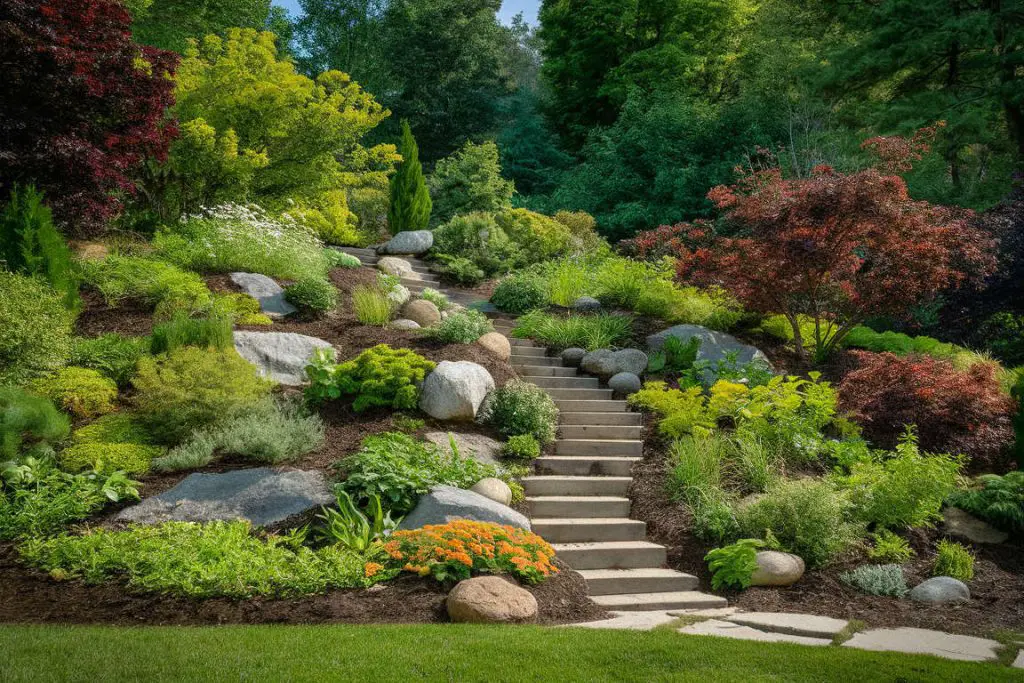
Achieving a lush, green hillside can be challenging, but a well-planned ground cover cascade makes it attainable. This layout utilizes a variety of ground covers to create a multi-layered effect that not only enhances the visual appeal of your slope but also addresses erosion issues effectively. Different heights and textures of ground covers work together to form a cohesive and low-maintenance landscape. Mulch between the plantings helps conserve moisture and suppress weeds, ensuring that your hillside remains vibrant with minimal upkeep.
Layout Description:
- Top of Slope: Start with taller ground covers like juniper or creeping juniper at the top for a cascading effect.
- Middle of Slope: Plant mid-height ground covers such as creeping thyme or vinca.
- Bottom of Slope: Finish with low-growing ground covers like sedum, which can spread out and fill gaps.
Key Features:
- Add a few decorative rocks or small boulders to create natural divisions.
- Use mulch between plantings to conserve moisture and reduce weeds.
Terraced Planting Landscape
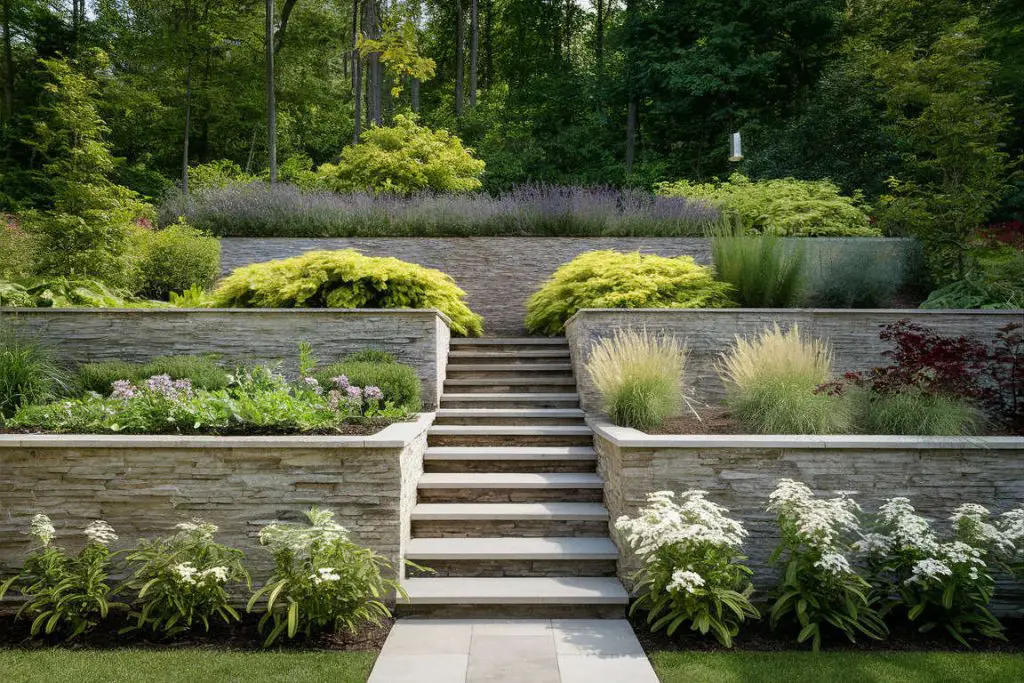
Transforming a steep slope into a series of terraced planting beds can turn a difficult area into a garden oasis. Terracing provides flat, usable spaces for planting a diverse array of shrubs, perennials, and ornamental grasses. The retaining walls offer stability to the soil and prevent erosion while creating distinct planting zones. Choosing low-maintenance plants like lavender and daylilies ensures that each terrace flourishes with little effort. Adding a stone pathway or steps makes it easy to navigate and enjoy your terraced garden.
Layout Description:
- Top Terrace: Construct a retaining wall and plant drought-tolerant shrubs like lavender and rosemary.
- Middle Terrace: Build another retaining wall below and plant ornamental grasses and perennials like daylilies.
- Bottom Terrace: Create the final retaining wall and plant lower-growing plants such as creeping phlox or ground cover roses.
Key Features:
- Integrate a stone pathway or steps for easy access.
- Incorporate a drip irrigation system to water plants efficiently.
Rock Garden Serenity
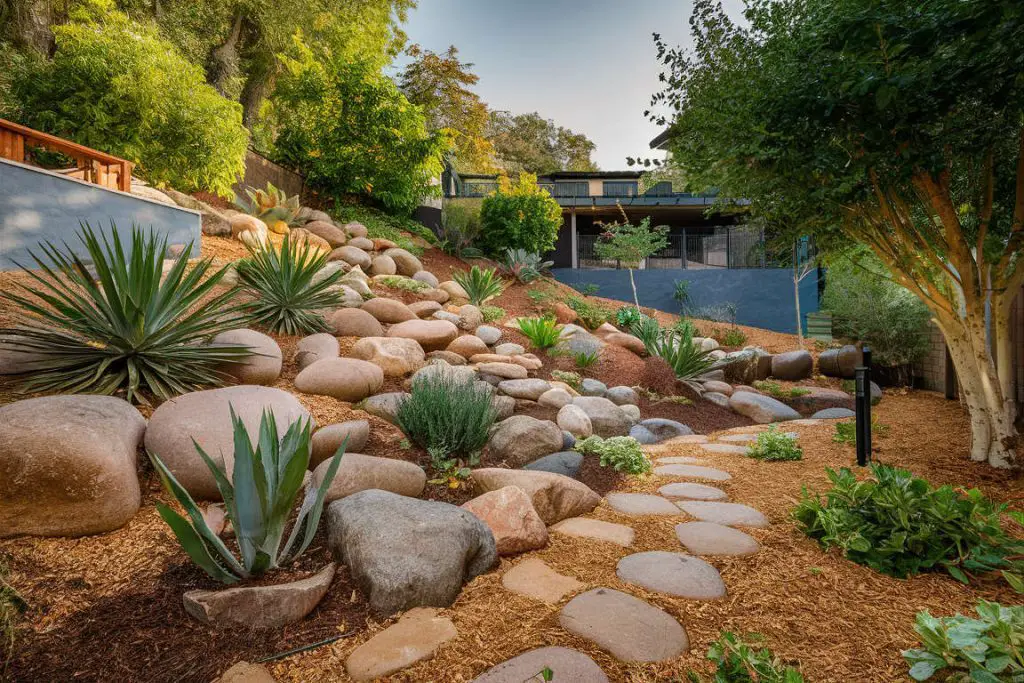
A rock garden on a hillside brings texture and natural beauty to your landscape. This design incorporates a mix of boulders, medium-sized rocks, and gravel, interspersed with drought-tolerant plants. The rocks help control erosion and create a visually interesting environment that mimics natural rocky landscapes. Plants like succulents and ornamental grasses thrive in this setting, needing minimal water and care. A small dry creek bed can add an additional layer of serenity and enhance the overall aesthetic of the garden.
Layout Description:
- Top Section: Place large boulders sporadically and plant yucca and other tall succulents.
- Middle Section: Use medium-sized rocks to create a natural flow and plant drought-tolerant plants like hens and chicks.
- Bottom Section: Fill in with smaller rocks and plant low-growing succulents and creeping ground covers.
Key Features:
- Use a variety of rock sizes to create visual interest.
- Include a small dry creek bed with gravel or river stones for added texture.
Native Plant Haven
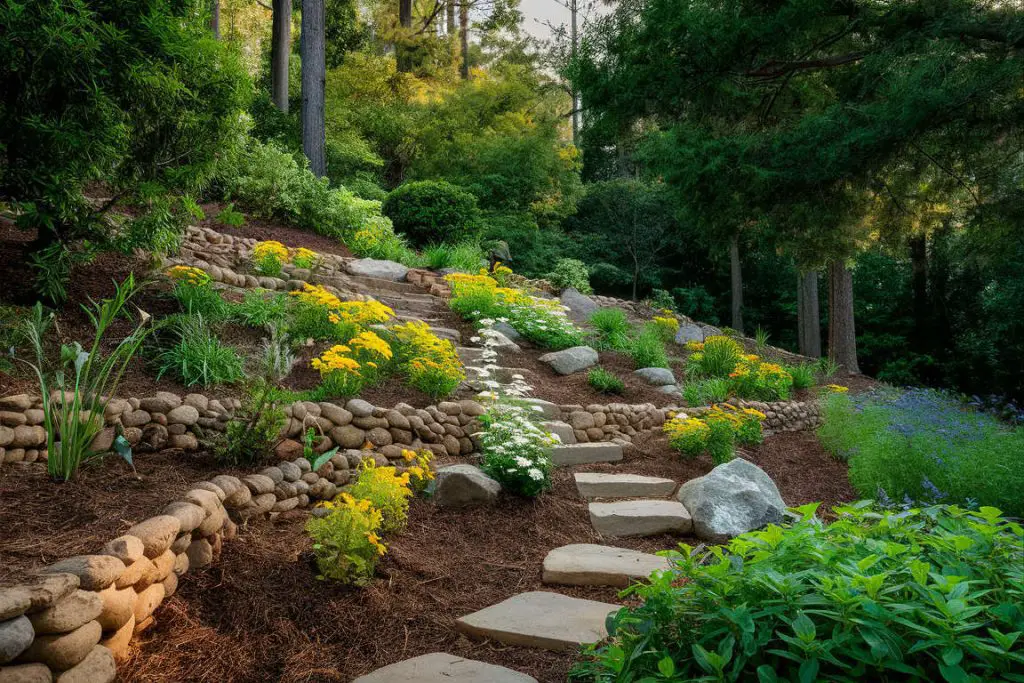
Using native plants in your hillside garden creates a sustainable and low-maintenance environment. Native species are adapted to the local climate and soil conditions, which means they require less water and care. This layout features a mix of taller shrubs, mid-height wildflowers, and low-growing ground covers, all native to the area. The natural look of native plants provides habitat for local wildlife and ensures that your garden thrives with minimal intervention. Adding natural stone or wood borders helps define the planting areas and adds structure to the design.
Layout Description:
- Top of Slope: Plant taller native shrubs like manzanita or sagebrush.
- Middle of Slope: Use mid-height native wildflowers such as black-eyed Susan and coneflower.
- Bottom of Slope: Finish with low-growing native ground covers like creeping mahonia or kinnikinnick.
Key Features:
- Add natural stone or wood borders to define planting areas.
- Use mulch paths to create accessible walking routes.
Drip-Irrigated Gradient
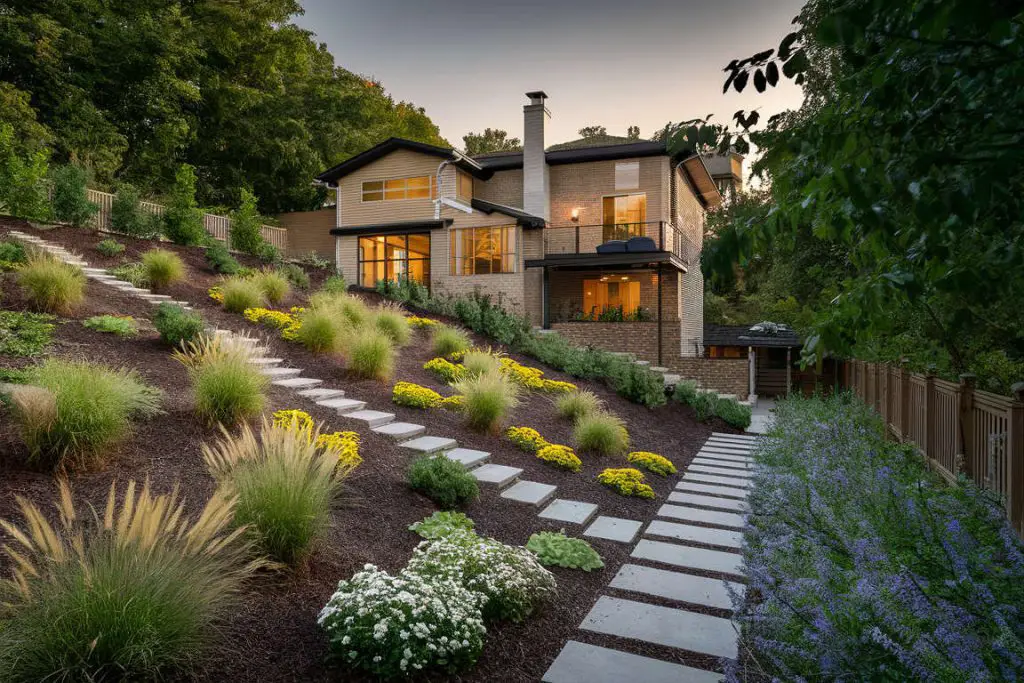
A drip-irrigated gradient combines efficient water use with a thoughtfully designed hillside garden. This layout involves installing a drip irrigation system that delivers water directly to the roots of each plant, reducing waste and promoting healthy growth. The design includes drought-tolerant shrubs, ornamental grasses, and perennials arranged in sections along the slope. The drip system ensures consistent moisture, while landscape fabric and mulch prevent weeds. Stepping stones or a gravel path provide easy access for maintenance, making this garden both practical and beautiful.
Layout Description:
- Top of Slope: Install a drip irrigation system and plant water-efficient shrubs like sage and yarrow.
- Middle of Slope: Continue the drip system and plant ornamental grasses and hardy perennials like echinacea.
- Bottom of Slope: Extend the drip system to the lowest section, planting ground covers and succulents.
Key Features:
- Use landscape fabric under mulch to prevent weeds.
- Incorporate stepping stones or a gravel path for access and maintenance.
Additional Tips for Achieving a Low-Maintenance Sloped Backyard
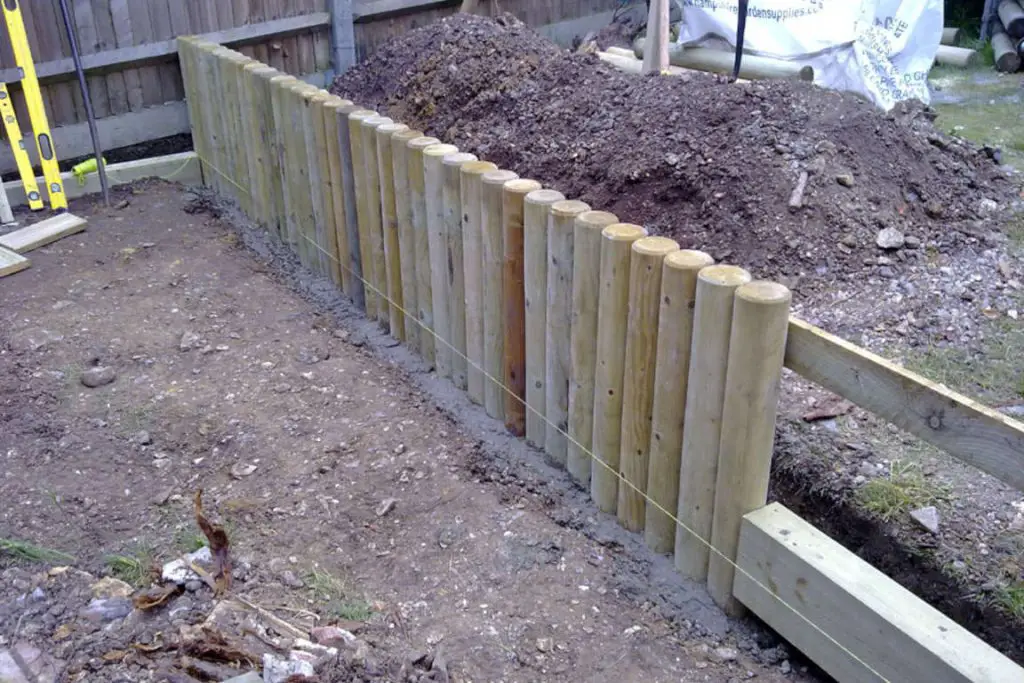
Creating a low-maintenance sloped backyard requires thoughtful planning and strategic choices. Implementing practical tips can significantly reduce the time and effort needed to maintain your garden while ensuring it remains healthy and attractive. Below are some additional tips to help you achieve a beautiful, low-maintenance hillside landscape.
Choose Drought-Tolerant Plants
Selecting drought-tolerant plants is essential for a low-maintenance garden. These plants thrive with minimal watering, making them ideal for sloped areas where water runoff can be an issue. Consider incorporating plants like lavender, sedum, and ornamental grasses, which are not only drought-tolerant but also add texture and color to your garden.
Use Mulch Generously
Mulch is a valuable ally in low-maintenance gardening. It helps retain moisture, suppresses weeds, and adds a finished look to your landscape. Spread a thick layer of mulch around your plants to reduce the need for frequent watering and weeding. Organic mulches, such as wood chips or bark, also improve soil health as they decompose.
Incorporate Retaining Walls
Retaining walls are not only functional but also enhance the visual appeal of a sloped garden. They provide structure, prevent soil erosion, and create flat planting areas. Materials like stone, brick, or wood can be used to build retaining walls that complement your garden’s aesthetic. Ensure proper drainage behind the walls to prevent water buildup.
Opt for Low-Growing Ground Covers
Ground covers are excellent for stabilizing soil on slopes and require minimal maintenance. Plants like creeping thyme, vinca, and ajuga spread quickly, covering large areas and reducing the need for mowing or trimming. These ground covers also help prevent erosion and can be combined with other plants for added interest.
Install an Efficient Irrigation System
An efficient irrigation system, such as drip irrigation, ensures that your plants receive the right amount of water with minimal waste. Drip systems deliver water directly to the roots, reducing evaporation and runoff. This method conserves water and keeps your plants healthy without the need for constant monitoring.
Plan for Easy Access
Designing your sloped garden with easy access in mind simplifies maintenance tasks. Paths, steps, or terraces allow you to reach all areas of your garden without difficulty. Use materials like gravel, stone, or wood to create durable and attractive pathways that blend seamlessly with your landscape design.
If you incorporate these tips they will help you be able to better manage your sloped garden yet allowing it to show its true beauty. Indeed, with the right choices, you can enjoy a stunning garden that requires minimal upkeep, allowing you more time to relax and appreciate your outdoor space.
Wrapping Up Your Hillside Haven
Transforming a hillside into a low-maintenance garden might seem challenging, but with the right strategies, it becomes a rewarding project. The designs we’ve explored offer practical and beautiful solutions to common slope issues, turning an unruly area into a stunning landscape. From ground cover cascades to terraced planting beds, each layout addresses erosion control, plant selection, and efficient watering methods.
Implementing some of additional tips we suggest, such as choosing drought-tolerant plants and installing an efficient irrigation system, further reduces maintenance efforts. Thoughtful planning and strategic choices make it possible to enjoy a vibrant, healthy garden without constant upkeep.
Use these ideas as inspiration, and refashion your hillside into a beautiful but manageable haven. Your outdoor space will not only enhance your home’s aesthetic appeal but also provide a peaceful retreat where you can relax and unwind. Enjoy the beauty and simplicity of a well-designed, low-maintenance hillside garden.
